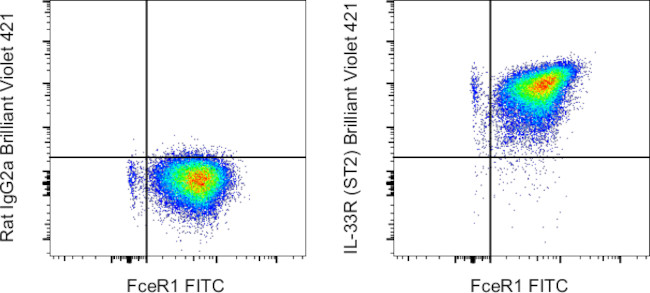Search Thermo Fisher Scientific
Invitrogen
IL-33R (ST2) Monoclonal Antibody (RMST2-2), Brilliant Violet™ 421, eBioscience™
FIGURE: 1 / 1
IL-33R (ST2) Antibody (404-9335-82) in Flow

Product Details
404-9335-82
Species Reactivity
Host/Isotype
Recommended Isotype Control
Class
Type
Clone
Conjugate
Excitation/Emission Max
Form
Concentration
Purification
Storage buffer
Contains
Storage conditions
Shipping conditions
RRID
Product Specific Information
Description: The RMST2-2 monoclonal antibody reacts with ST2, also known as IL-33 receptor (IL-33R) or interleukin 1 receptor-like 1. ST2 is a member of the IL-1 receptor family. In the membrane-bound form, it consists of three extra-cellular immunoglobulin domains and an intracellular toll-interleukin-1 receptor domain. ST2 forms a dimer with IL-1R accessory protein in a ligand-dependent manner. The IL-33/ST2 interaction induces the production of TH2 cytokines. ST2 also has a soluble isoform lacking transmembrane and intracellular toll-interleukin-1 receptor domains. It is believed that the soluble form functions as a decoy receptor that can block membrane bound IL-33/ST2 interaction. ST2 is expressed by TH2 lymphocytes, mast cells, eosinophils, basophils, innate lymphocytes, smooth muscle cells, and endothelial cells and is involved in host defense, allergy, and inflammation. The IL-33/ST2 interaction has also been shown to be atheroprotective.
Applications Reported: This RMST2-2 antibody has been reported for use in flow cytometric analysis.
Applications Tested: This RMST2-2 antibody has been tested by flow cytometric analysis of mouse bone marrow cells. This may be used at less than or equal to 0.5 µg per test. A test is defined as the amount (µg) of antibody that will stain a cell sample in a final volume of 100 µL. Cell number should be determined empirically but can range from 10^5 to 10^8 cells/test. It is recommended that the antibody be carefully titrated for optimal performance in the assay of interest.
Brilliant Violet™ 421 (BV421) is a dye that emits at 423 nm and is intended for use on cytometers equipped with a violet (405 nm) laser. Please make sure that your instrument is capable of detecting this fluorochrome.
When using two or more Super Bright, Brilliant Violet™, Brilliant Ultra Violet™, or other polymer dye-conjugated antibodies in a staining panel, it is recommended to use Super Bright Complete Staining Buffer (Product # SB-4401-42) or Brilliant Stain Buffer™ (Product # 00-4409-75) to minimize any non-specific polymer interactions. Please refer to the datasheet for Super Bright Staining Buffer or Brilliant Stain Buffer for more information.
Excitation: 407 nm; Emission: 423 nm; Laser: Violet Laser.
BRILLIANT VIOLET™ is a trademark or registered trademark of Becton, Dickinson and Company or its affiliates, and is used under license. Powered by Sirigen™.
Target Information
IL-33R, also known as ST2, is a receptor for IL-33. It is a member of the IL-1 receptor family of innate receptors. Its extracellular domain consists of 3 Ig-like domains that directly interact with its co-receptor IL-1RAcP, and the ligand alarmin, IL-33. IL-33 ligation results in the association of IL-33R complex with its adaptor proteins MyD88, IRAK1, IRAK4 and TRAF6, and activation of the NF-kB, and MAPK pathways. This, in turn, instigates the release of chemokines and cytokines such as IL-5, IL-6, IL-8, and IL-13. Two most common isoforms of IL-33R that result from alternative splicing are ST2L - the membrane bound form, and ST2S - the soluble form. The membrane bound form can be released from the cell surface by proteolytic cleavage. The soluble forms have been suggested to act as decoys dampening the IL-33 signaling. IL-33R is primarily expressed by mast cells, basophils, and eosinophils. In mouse, IL-33R expression has been shown on ILC2 and Th2 cells. IL-33R signaling has been implicated in the number of immune conditions, including allergies, arthritis, atherosclerosis and sepsis.
For Research Use Only. Not for use in diagnostic procedures. Not for resale without express authorization.
How to use the Panel Builder
Watch the video to learn how to use the Invitrogen Flow Cytometry Panel Builder to build your next flow cytometry panel in 5 easy steps.
References (0)
Bioinformatics
Protein Aliases: IL-1 R4; IL-1RL1; IL-33R; Interleukin-1 receptor-like 1; Interleukin-33 receptor alpha chain; Interleukin1 receptor like 1; Lymphocyte antigen 84; Protein ST2; Protein T1; sIL 33R; soluble IL 33 Receptor; soluble IL 33R
Gene Aliases: DER4; Fit-1; Il1rl1; Ly84; St2; St2-rs1; ST2L; Ste2; T1; T1/ST2
UniProt ID: (Mouse) P14719
Entrez Gene ID: (Mouse) 17082

Performance Guarantee
If an Invitrogen™ antibody doesn't perform as described on our website or datasheet,we'll replace the product at no cost to you, or provide you with a credit for a future purchase.*
Learn more
We're here to help
Get expert recommendations for common problems or connect directly with an on staff expert for technical assistance related to applications, equipment and general product use.
Contact tech support

